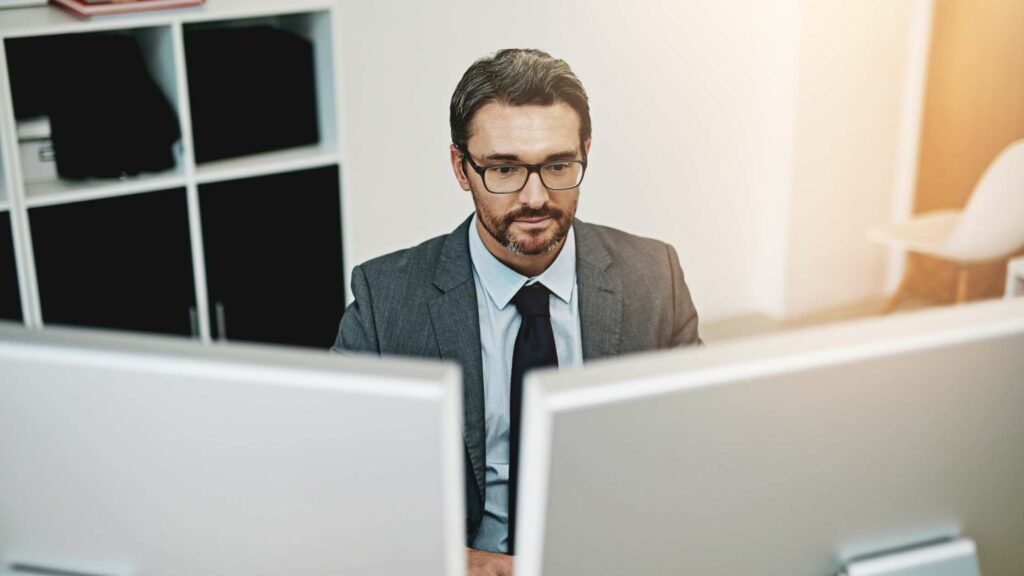The virtual assistant vs employee discussion is now more important than ever for any entrepreneur or business owner.
Both hires can carry out many of the same duties, such as basic administrative tasks, office management, personal assistant duties, and social media management.
But how do you determine which is the better option for you?
In this article, we’ll help you compare a virtual assistant vs an employee. We’ll explore their benefits and disadvantages and help you find a suitable option.
This article covers:
(Click on a link below to jump to a specific section)
- Virtual Assistant vs Employee
- Virtual Assistant: Advantages and Disadvantages
- Employee: Advantages and Disadvantages
- Finding the Right Fit: Virtual Assistant vs Employee
Let’s start.
Virtual assistant vs employee
First, let’s define what a virtual assistant and an employee are and understand their essential differences.
A. Who is a virtual assistant?
A virtual assistant (VA) or a virtual professional is an independent contractor who typically works from a home office (remote worker) or outside of the client’s office to provide virtual assistance and services.
They have access to all necessary planning documents (such as shared calendars), essential hardware (laptop and mobile), and software tools.
You can contact this independent contractor (remote assistant) to undertake specific tasks for you from a remote location (home or virtual office).
The tasks can include:
- Administrative work.
- Personal assistant tasks.
- Content creation.
- Customer service.
- Social media management.
- And more.
The payment may be an hourly rate or fixed monthly rate (depends) and is based on their work performance.
Need more information?
Check out our complete guide on virtual assistants to find out what they do and how to hire them.
B. Who is an employee?
An employee is an individual who works full-time or part-time under a contract of employment (oral or written). They have recognized rights and duties.
This individual (traditional employee) is a permanent team member of your staff and has a specific duty to perform. Typically they work with you while they’re physically present on the office premises.
However, they can work remotely as well and yet be permanent members of the team (remote employees).
As a business owner or employer, you have to pay each permanent employee a salary (with a fixed monthly or hourly rate) and offer them a range of employee benefits.
Now that we’ve defined them, let’s find out the advantages and disadvantages of both virtual assistants and employees.
Virtual assistant: Major advantages and disadvantages

Virtual assistants are quite the buzz with new entrepreneurs and small business owners.
But before you post a virtual assistant job advertisement or contact a virtual assistant service company, you need to know its pros and cons.
A. 6 key advantages of a virtual assistant
Here are some important advantages of a virtual assistant:
1. Diverse skill set
They’re not only capable of carrying out every administrative task (scheduling appointments, data entry, scheduling meetings with clients, bookkeeping, etc.), but some of them are also experts in:
- Social media marketing.
- Social media promotion.
- Logistics.
- SEO.
- Content writing (blogs, social media posts, website content, etc.).
- Photo and video editing.
- Real estate (handle customer queries, generate leads, upload property photos, etc.).
- Technical support.
The list can go on! Check out these 100 tasks a virtual assistant can perform.
2. Flexible schedule and affordable payment benefit
The first and direct benefit you enjoy as an employer is that you’ll only have to pay a virtual assistant for actual hours worked or per project completed.
Another option you get is agreeing on a monthly retainer, which implies you pay the virtual assistant a minimum fee, irrespective of the task load.
3. Flexibility of hire
You can hire a virtual assistant freelancer if you’re looking for part-time, short-term, or project-based contracts. In other words, you can contact them depending on your need, such as during peak season, a weekend, at night, or during a holiday.
A freelance virtual assistant is perfect when you don’t want to invest in overhead expenses unrelated to your business’s product or services, or you’re a small business owner with limited funds. This will help you stick to a budget.
4. No training cost
Your virtual assistant will upgrade their skills and grow their knowledge on their own time to become more competitive. As a result, you won’t have any training expenses to worry about.
5. Large talent pool
You can access a massive talent pool because your virtual assistant can be from any part of the world. This naturally increases your possibility of finding suitable virtual assistance.
6. Cost savings
Virtual assistant cost is quite affordable and sometimes even cheap.
Hiring a virtual assistant means no employee-related tax, no hardware investment cost, and no office space expense.
You only have to pay for the work they do, with no additional cost.
However, virtual assistants are not entirely the perfect option.
Before you find a quality virtual assistant company and start hiring, let’s explore the cons of a virtual assistant.
B. 4 major disadvantages of a virtual assistant
Here are some important disadvantages of a virtual assistant you should know of:
1. Difficult to track accurate work hours
This typically depends on the platform or software you use to track your virtual assistant’s work hours.
You can either track hours and confirm actual work done very efficiently or depend on unreliable self-reported data. There’s no in-between.
Fortunately, you can invest in quality software to avoid unreliable tracking and eliminate room for deceitful practice.
For example, Time Doctor is a good productivity management tool for your virtual assistants.
What’s Time Doctor?

Time Doctor is an efficient employee productivity management and time tracking software that can help you monitor your virtual assistants.
The tool is used by major companies as well as by small businesses to boost productivity across the board.
2. Irregular communication
Since virtual assistants do remote work, there may be some irregularities in your communication.
For example, if you have a task that needs immediate attention and your virtual assistant doesn’t have fixed working hours, chances are they won’t be available right away at your service.
As a result, your work may get delayed.
This also might be the case if your virtual assistant belongs to a different time zone, and you will have to wait for them to log in to work.
3. Virtual assistant’s technical difficulties
Technical difficulties on your virtual assistant’s end can affect your productivity and work since they’re out of your control.
Some of them may include:
- Hardware issues like broken computers or mobile.
- Loss of internet connection.
- Difficulty in understanding new software.
4. Split focus
If you hire a virtual assistant who’s a freelancer or part-time employee, they may have more than one client or job.
This means you’ll have a virtual staff that may find it difficult to keep up with work and may show in the form of poor productivity now and then.
Now let’s move on to the pros and cons of hiring a full time employee.
Employee: Advantages and disadvantages

Even though the advantages of a virtual assistant are many, several business owners would rather hire a traditional employee instead.
Let’s find out why.
A. 3 key advantages of an employee
Here are some important advantages of an employee that you’ll appreciate as an employer:
1. Loyalty
Your new employee will likely feel committed to you as an employer and strive to give their best at work.
Why?
As a permanent member of the team, they have job security and are aware of their rights, responsibilities, and benefits.
This is invaluable for productivity, smooth operations, and business success.
2. Stronger communication
Since an employee is an in-house assistant, your chances of communication gaps reduce.
Whether you need to have a conversation with them, clarify a doubt, or need some help, you can do it immediately without worrying about them not being around.
This is possible because your permanent employees mostly work at the same time as everyone else in your company.
3. Human relations
Unlike virtual assistants, employees are typically around (physically or remotely) when everyone, or at least their team, is on duty.
This allows them to develop human relations with their colleagues, something virtual assistants are often deprived of. The human connection keeps a lot of people highly productive, happier in general, and you can also see how they interact with your other employees.
However, hiring a permanent part time or full time employee isn’t entirely perfect either.
B. 5 major disadvantages of an employee
Here are some major disadvantages of a traditional employee that you must consider before investing in the hiring process:
1. Expensive investment
A full time employee is a sizable investment. There are costs related to office space maintenance (infrastructure and equipment), payroll taxes, etc.
You may even need to consider employee benefits such as:
- Paid sick leaves.
- Holiday pay.
- Performance bonus.
- Fringe benefits.
- Corporate discounts.
- Worker’s compensation
- Healthcare.
- Life insurance.
- Parental leaves
- Wellness programs
- And more.
2. High training cost
With a permanent employee, you need to bear the cost necessary for onboarding and training purposes. Unlike a virtual assistant, upgrading their work-related abilities is your responsibility to a large extent.
Moreover, it doesn’t help when the training takes away time from work hours. So you might end up spending money and too much time.
3. Not flexible
An in-house assistant or employee has a specific role and an expected task to complete each day.
You can move around tasks depending on your priorities, but the employee may not be able to accommodate last-minute changes with a fixed schedule. And even if they do, their work quality may suffer.
4. Fixed salary
As an entrepreneur or business owner, you’ll have to pay your employee a regular fixed salary, irrespective of the workload.
This means you’ll have to pay them the same salary even if you go through long periods where there’s not enough work for the employee to do.
Fixed salary and schedule also imply that you need to pay your employee for overtime if they need to work outside of regular working hours.
5. High replacement cost
If you want to replace your full time employee, you will suffer some financial losses from lost productivity during the turnover period and even from advertising or recruiter expenses.
Additionally, you also need to consider the cost of training and helping employees adjust to their new office as well as colleagues.
Finding the right fit: Virtual assistant vs employee
The simplest way to find the right fit between a virtual assistant and an employee is to ask yourself the following questions:
1. Do you need a dedicated assistant or temporary/trial basis solution?
You can rely on an employee for dedicated assistance (long-term support), while a virtual assistant is great for short-term projects.
2. What is your budget?
If you’re an entrepreneur or a small business owner with a small budget, maybe hiring a virtual assistant is more cost-effective.
And if you have the budget to hire an in-house assistant and pay for overhead expenses, then an employee is the right answer for you.
3. What is the complexity of your daily tasks?
If your daily tasks are simple but repetitive, a virtual assistant is a good option for you.
However, if your tasks need them to work with other team members or needs on-the-job training often, an employee is a better choice, especially if your projects are ever-evolving.
Answering these questions should help you understand your requirements and whether to hire a virtual assistant or an employee.
Final thoughts
The easiest and smartest way to choose between a virtual assistant and an employee is to figure out your company’s specific needs and services.
Once you know that, you can weigh the advantages and disadvantages of hiring a virtual assistant and an employee that we’ve mentioned in this article. And this will help you make the right call for your business needs.

Andy is a technology & marketing leader who has delivered award-winning and world-first experiences.


